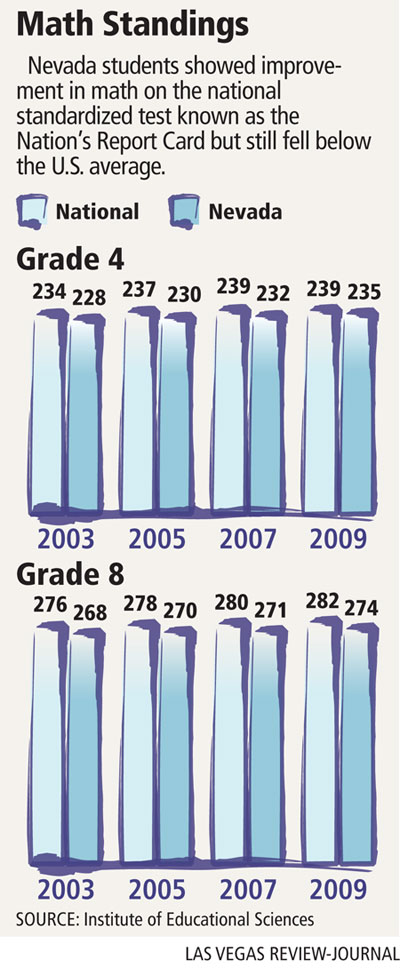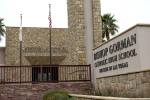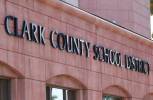Nevada improves in math
Nevada is one of four states that improved math scores in fourth grade and eighth grade in 2009, according to test results released Wednesday.
"It was probably the best news we've had in a while," said Nevada Superintendent of Public Instruction Keith Rheault.
Nevada still has room to improve, Rheault acknowledged. Student scores in the state remain below the national average.
Rheault was pleased that Nevada has been showing steady progress on the National Assessment of Educational Progress since testing began in 1996. NAEP is a series of federally funded achievement tests often referred to as the nation's report card. Students are tested in nine subjects, but they are tested most often in math and reading. Generally, students have been making more progress in math than in reading.
On a 500-point scale, the average fourth-grade score was 235, and the average eighth-grade score was 274 for Nevada. Nationally, the average score was 239 for fourth grade and 282 for eighth grade.
The state has made gains though its percentage of fourth-grade English language learners is twice the national average. Twenty percent of Nevada fourth-graders are identified as English language learners compared with 10 percent across the nation.
Rheault also said minority groups are showing test score gains. In 2009, 70 percent of Hispanics in fourth grade showed basic competence in math. In 1996, 37 percent of Hispanic fourth-graders tested at the same level.
Rheault gave some of the credit for the gains to the state's emphasis on remediation and its requirement that every public school have an improvement plan to raise test scores.
Anna Habash, a policy analyst for Education Trust, a national nonprofit organization, said Nevada still has much work to do to if it wants to become a state that performs in the top tier.
"You have to start somewhere," Habash said. "At least Nevada is moving in the right direction."
Three thousand students in Nevada took the NAEP math test. Rheault estimated that 70 percent were from Clark County. This year's NAEP math tests were given to 168,800 fourth-graders and 161,700 eighth-graders in public and private schools in every state.
Nationally, the math scores show fourth-graders have made no gains since 2007, the first time in two decades they have failed to improve. Eighth-graders advanced for yet another year.
Education officials called the results troubling though it is impossible to know from one test whether progress over the long term has stalled.
"We're clearly not requiring enough of our math teachers," said David Driscoll, chairman of the board that oversees the tests and a former education commissioner in Massachusetts.
Teachers are crucial to learning, said Driscoll, who noted that eighth-graders whose teachers majored in math scored 9 points higher than other students on this year's test.
But teachers lack training even in his state, which posted the highest scores in math. When Massachusetts beefed up the math portion of the elementary teacher test in 2007, 55 percent of teachers failed, he said.
The scores put 39 percent of fourth-graders and 32 percent of eighth-graders at the proficient level, meaning they show the knowledge and skills they should have at that grade.
That means millions of students fall short of meeting the goal of the federal No Child Left Behind law championed by President George W. Bush, which is that every student can read and do math at their grade level by 2014.
Congress hopes to rewrite the law next year.
Education Secretary Arne Duncan said the results mean "the status quo isn't good enough."
"These NAEP results are a call to action for reforms that will prepare our students to compete in the global economy," Duncan said.
Tom Loveless, an education expert at the Brookings Institution think tank, said the results really weren't much different from 2007. It will take another four to six years to see whether fourth-grade progress has truly stalled, he said.
"Each of these is kind of like a public opinion poll; it's an estimate," Loveless said. "I think people rush to take each release of test scores far too seriously and try to explain every little wiggle in the data."
Loveless said it is impossible to explain exactly why national fourth-grade scores did not budge. "Scientifically, you cannot explain in education why a phenomenon did not happen," he said.
According to the results:
• Four states and the District of Columbia managed to show improvement in both fourth and eighth grades. With Nevada, the states are New Hampshire, Rhode Island and Vermont.
• Three states saw improvement in fourth grade only: Colorado, Kentucky and Maryland. Ten states saw improvement in eighth grade only; they are Connecticut, Georgia, Hawaii, Idaho, Missouri, Montana, New Jersey, South Dakota, Utah and Washington.
• In four states, scores dropped among fourth-graders: Delaware, Indiana, West Virginia and Wyoming.
In addition, there was no nationwide progress from 2007 to 2009 in closing the gap between minority and white students in either grade, though the gap has narrowed somewhat since the 1990s. Black and Hispanic students did make gains at eighth grade, but the gap persisted because white students improved, too.
Experts say that divide, considered one of the toughest challenges in education, is driven by deeply rooted factors. More minority children live in poverty, which is linked to several problems that interfere with learning.
Another reason the gap has persisted is demographics. White children made up about 75 percent of students tested in the 1990s but today make up less than 60 percent.
Private-school students continue to outperform those in public schools, according to the scores. Private school math scores were 7 points better in fourth grade and 14 points better in eighth grade.
The Associated Press contributed to this report. Contact reporter James Haug at jhaug@reviewjournal.com or 702-374-7917.
National Assessment of Educational Progress




























